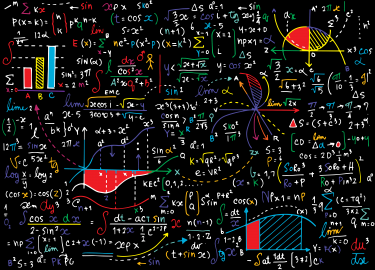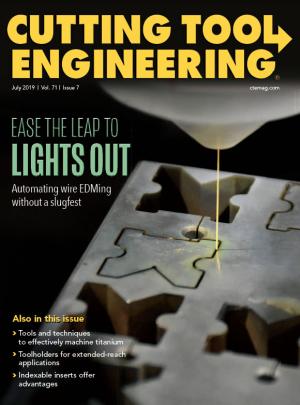 Author Edmund Isakov, Ph.D.
Author Edmund Isakov, Ph.D.

Boring is an internal turning operation performed with a boring bar to enlarge a previously drilled hole to form an internal shape of specified dimensions. Boring operations range from semiroughing to finishing.
A boring bar has three basic elements: an indexable cutting insert, a shank and an anchor. The designation system for indexable inserts is the same as for turning. The anchor is the clamping portion of the shank that is held in the tool block, and the minimum clamping length is approximately three to four diameters of the shank. The distance the boring bar extends beyond the tool block, which is called overhang, determines the cutting depth. The overhang is the unsupported portion of the boring bar. Long overhang causes excessive deflection of the shank and generates vibration, or chatter, which deteriorates the surface finish of the bore.
Eliminating chatter, especially when boring deep holes, is one of the greatest challenges faced by manufacturers and users of boring bars. Deflection of a boring bar depends on the mechanical properties of the shank material, the length of the overhang and the cutting conditions.
The following equation is used to calculate deflection (y) of a boring bar:
y = FL3/3EI (1)
Where
F is the cutting force, lbf or N.
L is the unsupported length of a boring bar (overhang), in. or mm.
E is the modulus of elasticity (in tension) of a boring bar material, psi or N/mm2.
I is the moment of inertia of a boring bar cross section area, in.4 or mm4.
Boring Bar Deflection Calculator
Formula: y = (F * L³) / (3 * E * I)
Cutting Force
Cutting force (F) expressed in customary U.S. units of measure, calculated by formula (2):
F = 396,000 × d × f × Kp × C (2)
Where
The number 396,000 is expressed through:
A unit of power equal to 550 ft.-lbs./sec.: 550.
A unit of power equal to 550 ft.-lbs./min.: 550 × 60 = 33,000.
A unit of power equal to 550 in.-lbs./min.: 33,000 × 12 = 396,000.
d is DOC, in.
f is a feed rate, ipm.
Kp is a power constant, hp/in.3/min.
C is the feed rate factor for the power constant adjustment.
Example of calculating the cutting force (F)
Given:
The workpiece is AISI 4140 chromium-molybdenum steel, 220 to 240 HB.
DOC, d = 0.08".
Feed rate, f = 0.008 ipr.
Power constant, Kp = 0.76 hp/in.3/min.
Feed factor, C = 1.08.
Adjusted power constant, Kpa = Kp × C = 0.76 × 1.08 = 0.82.
Calculating:
F = 396,000 × d × f × Kpa = 396,000 × 0.08 × 0.008 × 0.82 = 207.8 lbf
Cutting force (F) expressed in metric units of measure, calculated by formula (3).
F = 60,000 × d × f × Kp × C (3)
Where
The number 60,000 is expressed through:
A unit of power equal to 1kW × m/sec.: 1.
A unit of power equal to 1kW × m/min.: 1 × 60 = 60.
A unit of power equal to 1kW × mm/min.: 1,000 × 60 = 60,000.
d is DOC, mm.
f is a feed rate, mm/min.
Kp is a power constant, kW/cm3/min.
C is the feed rate factor for the power constant adjustment.
Example of calculating the cutting force (F)
Given:
The workpiece is AISI 4140 chromium-molybdenum steel, 220 to 240 HB.
DOC, d = 2.03mm.
Feed rate, f = 0.2mm/rev.
Power constant, Kp = 0.0346kW/cm3/min.
Feed factor, C = 1.08.
Adjusted power constant, Kpa = Kp × C = 0.0346 × 1.08 = 0.0374.
Calculating:
F = 60,000 × d × f × Kpa = 60,000 × 2.03 × 0.2 × 0.0374 = 911.1 N
Comparing the data of the cutting forces, we can say that formulas (2) and (3) provide sufficient
accuracy.
By converting the cutting force of 207.8 lbf (customary U.S. units of measure) into metric units of measure, we get:
F = 207.8 × 4.448 = 924.3 N (compare with 911.1 N)
The difference is:
924.3 N - 911.1 N = 13.2 N, or 1.4%
By converting the cutting force of 911.1 N (metric units of measure) into customary U.S. units of measure, we get:
F = 911.1 N × 0.2248 = 204.8 lbf (compare with 207.8 lbf)
The difference is:
207.8 lbf - 204.8 lbf = 3 lbf, or 1.4%
Cutting Force Calculator (U.S. Units)
Formula: F = 396,000 * d * f * Kp * C
Moduli of Elasticity
Boring bar shanks are made of steel, tungsten-base alloys or cemented carbide. The most frequently used boring bar material is alloy steel. Some boring bar manufacturers use AISI 1144 free-machining medium-carbon steel. Regardless of their grades, all carbon and alloy steels have the same modulus of elasticity:
Customary U.S. units of measure: E = 30 × 106 psi (4)
Metric units of measure: E = 20.6 × 104 N/mm2 (5)
A common mistake is to assume that a steel shank with a higher hardness or a steel shank made from higher-quality steel will deflect less. As can be seen from equation (1), the material property that determines deflection is the modulus of elasticity. Hardness does not appear in this equation.
Tungsten heavy alloys for boring bars: E = (45 to 48) × 106 psi (customary U.S. units of measure) and E = (31 to 33) × 104 N/mm2 (metric units of measure).
Boring bars made of tungsten heavy alloys will deflect less than steel boring bars of the same diameter and overhang by 50% to 60% when cutting at the same DOC and feed rate.
Cemented carbides for boring bars: E = (84 to 89) × 106 psi (customary U.S. units of measure) and E = (52 to 61) × 104 N/mm2 (metric units of measure).
Boring bars made of cemented carbide provide minimum deflection because their moduli of elasticity are higher than those of steel and tungsten heavy alloys.
Modulus of Elasticity Converter
Moment of Inertia
The moment of inertia is a property of areas. Because boring bars are available in various diameters, it is important to calculate the area of a bar cross section using appropriate formulas. A boring bar is usually round with a solid or tubular cross section. The moment of inertia of a solid cross section area is calculated by:
I = π × D04 ÷ 64 (6)
Where D0 is a bar OD in in. or mm. Moment of inertia of a tubular cross section area is calculated by:
I = π × (D04 - Di4) ÷ 64 (7)
Where Di is a bar ID in in. or mm.
Example of calculating the moment of inertia I (customary U.S. units of measure)
Given: Outside diameter is 1". The moment of inertia is calculated using formula (6).
I = π × 14 ÷ 64 ≈ 0.0491 in.4
Example of calculating the moment of inertia I (metric units of measure)
Given: OD is 25.4mm. The moment of inertia is calculated using formula (6).
I = π × 25.44 ÷ 64 = π × 416,231.4 ÷ 64 = π × 6,503.6 = 20,432mm4
Moment of Inertia Calculator (Solid Bar)
Formula for solid bar: I = π * D⁴ / 64
Deflection
Example 1: Unsupported length of a boring bar (overhang), L = 4".
Calculating deflection of the bar (customary U.S. units of measure)
y = FL3 ÷ 3EI = 207.8 × 43 ÷ 3 × 30 × 106 × 0.0491 = 12,652.8 ÷ 4,419,000 ≈ 0.003"
Example 2: Unsupported length of a boring bar (overhang), L = 101.6mm
Calculating deflection of the boring bar (metric units of measure)
y = FL3 ÷ 3EI = 911.1 × 101.63 ÷ 3 × 20.6 × 104 × 20,432 = 955,536,257 ÷ 3 × 4,208,992,000 = 0.0757mm
Let’s compare: Deflection of the boring bar in example 1 is 0.003", or 0.0762mm, and deflection of the boring bar in example 2 is 0.0757mm, or 0.00298".
To help ensure a successful boring operation, the overhang should be as short as possible to minimize boring bar deflection. In addition, the boring bar should be made of either tungsten heavy alloy or cemented carbide, and the bar diameter should be as large as possible to achieve the maximum moment of inertia.
Related Glossary Terms
- Brinell hardness number ( HB)
Brinell hardness number ( HB)
Number related to the applied load (usually, 500 kgf and 3,000 kgf) and to the surface area of the permanent impression made by a 10mm ball indenter. The Brinell hardness number is a calculated value of the applied load (kgf) divided by the surface area of the indentation (mm2). Therefore, the unit of measure of a Brinell hardness number is kgf/mm2, but it is always omitted.
- alloy steels
alloy steels
Steel containing specified quantities of alloying elements (other than carbon and the commonly accepted amounts of manganese, sulfur and phosphorus) added to cause changes in the metal’s mechanical and/or physical properties. Principal alloying elements are nickel, chromium, molybdenum and silicon. Some grades of alloy steels contain one or more of these elements: vanadium, boron, lead and copper.
- alloys
alloys
Substances having metallic properties and being composed of two or more chemical elements of which at least one is a metal.
- boring
boring
Enlarging a hole that already has been drilled or cored. Generally, it is an operation of truing the previously drilled hole with a single-point, lathe-type tool. Boring is essentially internal turning, in that usually a single-point cutting tool forms the internal shape. Some tools are available with two cutting edges to balance cutting forces.
- boring bar
boring bar
Essentially a cantilever beam that holds one or more cutting tools in position during a boring operation. Can be held stationary and moved axially while the workpiece revolves around it, or revolved and moved axially while the workpiece is held stationary, or a combination of these actions. Installed on milling, drilling and boring machines, as well as lathes and machining centers.
- cemented carbides
cemented carbides
Typical powder-metallurgical products. They are sintered compounds of cobalt (or another binder metal) and carbides of refractory metals suitable for use as a cutting tool material. The majority of metalcutting indexable inserts are multicarbide compounds of tungsten carbide, titanium carbide, tantalum carbide and/or niobium carbide with cobalt as a binder metal.
- chatter
chatter
Condition of vibration involving the machine, workpiece and cutting tool. Once this condition arises, it is often self-sustaining until the problem is corrected. Chatter can be identified when lines or grooves appear at regular intervals in the workpiece. These lines or grooves are caused by the teeth of the cutter as they vibrate in and out of the workpiece and their spacing depends on the frequency of vibration.
- cutting force
cutting force
Engagement of a tool’s cutting edge with a workpiece generates a cutting force. Such a cutting force combines tangential, feed and radial forces, which can be measured by a dynamometer. Of the three cutting force components, tangential force is the greatest. Tangential force generates torque and accounts for more than 95 percent of the machining power. See dynamometer.
- depth of cut
depth of cut
Distance between the bottom of the cut and the uncut surface of the workpiece, measured in a direction at right angles to the machined surface of the workpiece.
- feed
feed
Rate of change of position of the tool as a whole, relative to the workpiece while cutting.
- hardness
hardness
Hardness is a measure of the resistance of a material to surface indentation or abrasion. There is no absolute scale for hardness. In order to express hardness quantitatively, each type of test has its own scale, which defines hardness. Indentation hardness obtained through static methods is measured by Brinell, Rockwell, Vickers and Knoop tests. Hardness without indentation is measured by a dynamic method, known as the Scleroscope test.
- inches per minute ( ipm)
inches per minute ( ipm)
Value that refers to how far the workpiece or cutter advances linearly in 1 minute, defined as: ipm = ipt 5 number of effective teeth 5 rpm. Also known as the table feed or machine feed.
- inner diameter ( ID)
inner diameter ( ID)
Dimension that defines the inside diameter of a cavity or hole. See OD, outer diameter.
- mechanical properties
mechanical properties
Properties of a material that reveal its elastic and inelastic behavior when force is applied, thereby indicating its suitability for mechanical applications; for example, modulus of elasticity, tensile strength, elongation, hardness and fatigue limit.
- modulus of elasticity
modulus of elasticity
Measure of rigidity or stiffness of a metal, defined as a ratio of stress, below the proportional limit, to the corresponding strain. Also known as Young’s modulus.
- outer diameter ( OD)
outer diameter ( OD)
Dimension that defines the exterior diameter of a cylindrical or round part. See ID, inner diameter.
- shank
shank
Main body of a tool; the portion of a drill or similar end-held tool that fits into a collet, chuck or similar mounting device.
- turning
turning
Workpiece is held in a chuck, mounted on a face plate or secured between centers and rotated while a cutting tool, normally a single-point tool, is fed into it along its periphery or across its end or face. Takes the form of straight turning (cutting along the periphery of the workpiece); taper turning (creating a taper); step turning (turning different-size diameters on the same work); chamfering (beveling an edge or shoulder); facing (cutting on an end); turning threads (usually external but can be internal); roughing (high-volume metal removal); and finishing (final light cuts). Performed on lathes, turning centers, chucking machines, automatic screw machines and similar machines.



